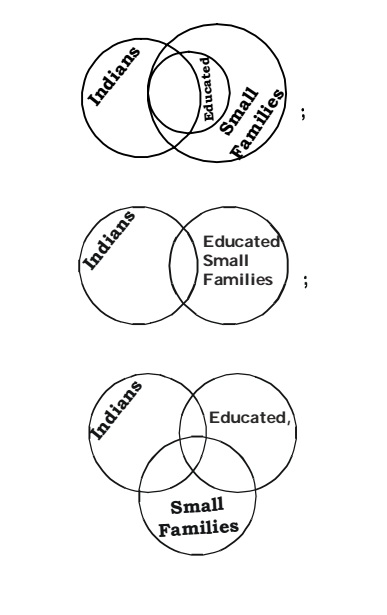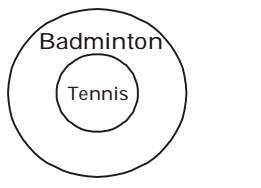Syllogism
Direction: In this question some statements are given. You have to consider the statements to be true even if they seem to be at variance from commonly known facts. You have to decide which of the given conclusion, if any, follows from the given statement.
- All men are mortal.
Ramu is a man.
-
View Hint View Answer Discuss in Forum
All men (without exception) are mortal.
And, Ramu is a man.Correct Option: B
All men (without exception) are mortal. And, Ramu is a man. Therefore, Ramu is mortal.
Direction: Two statements are given followed by two conclusions I and II. You have to consider the two statements to be true even if they seem to be at variance from commonly known facts. You have to decide which one of the given conclusions is definitely drawn from the given statements.
- Statements:
Some Indians are educated.
Educated men prefer small families.
Conclusions:
(I) All small families are educated.
(II) Some Indians prefer small families.
-
View Hint View Answer Discuss in Forum
Draw a figure and solve the question.
First statement is Particular Affirmative (I-type).
Second statement is Universal Affirmative (A-type)
Both the statements are already aligned. Thus,
Some Indians are educated. ↔ All Educated men prefer small families.Correct Option: B
First statement is Particular Affirmative (I-type).
Second statement is Universal Affirmative (A-type)
Both the statements are already aligned. Thus,
Some Indians are educated. ↔ All Educated men prefer small families.
We know that,
I + A ⇒ I-type Conclusion. Therefore, our derived Conclusion would be: “Some Indians prefer small families.
Venn-diagrams
Direction: In question No. 28 a statement is given followed by four conclusions (1) to (4). You have to consider the statements to be true even if it seems to be at variance from commonly known facts. You have to decide which one of the given conclusions are definitely drawn from the given statement.
- ‘All the members of the Tennis club are members of the Badminton club too." "No woman plays Badminton”.
-
View Hint View Answer Discuss in Forum
Draw a figure and solve the question.
Correct Option: D
No woman plays badminton. Therefore, no woman plays tennis.

- Which one is true?
I. All players are not tall.
II. All basketball players are tall.
III. All tall people are players.
IV. Some players are tall.
-
View Hint View Answer Discuss in Forum
Statements 1 and 4 are more or less similar.
Correct Option: C
Statements 1 and 4 are more or less similar.
All tall people cannot be players.
So, Statement 2 seems to be true.
- Statement:
(I) All cities are towns.
(II) Some cities are villages.
Conclusions:
(I) All villages are towns.
(II) No village is a town.
(III) Some villages are towns.
-
View Hint View Answer Discuss in Forum
(i) All cities are towns → Universal Affirmative (A - type).
(ii) Some cities are villages → Particular Affirmative (I - type).
(iii) No village is a town → Universal Affirmative (E - type).
(iv) Some villages are not towns → Particular Negative (O type).Correct Option: A
(i) All cities are towns → Universal Affirmative (A - type).
(ii) Some cities are villages → Particular Affirmative (I - type).
(iii) No village is a town → Universal Affirmative (E - type).
(iv) Some villages are not towns → Particular Negative (O type).
Some villages are cities. ↔All cities are towns.
I + A ⇒I - type of Conclusion “Some villages are towns”.
This is Conclusion III.

